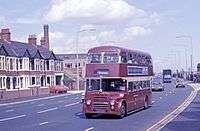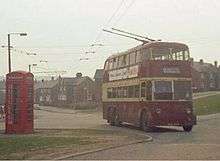Cardiff Bus
 | |
|
Alexander Dennis Enviro400 in Cardiff in September 2015 | |
| Parent | Cardiff Council |
|---|---|
| Founded | May 1902 |
| Headquarters | Leckwith |
| Service type | Bus services |
| Fleet |
209 vehicles (September 2015) |
| Chief executive | Cynthia Ogbonna |
| Website | www.cardiffbus.com |
Cardiff Bus[1] (Welsh: Bws Caerdydd) is the dominant operator of bus services in Cardiff, Wales and the surrounding area, including Barry and Penarth. Its hub is Cardiff central bus station. The company is wholly owned by Cardiff Council[2][3] and is one of the few municipal bus companies to remain in council ownership.
History




.jpg)
While horse buses (and later horse trams) had run in the city since 1845, Cardiff Bus can trace its history back to May 1902, when Cardiff Council took over and electrified a tram line between Roath and the city centre. It had been previously run by the Cardiff Tramway Company. The resultant Cardiff Corporation Tramways spent the next three decades extending its electric tram network, and at its peak in 1927 ran 141 electric trams over 18 miles of line. On Christmas Eve 1920, the corporation introduced its first bus, although the first motor bus route was operated by the Tramway Company from 1907.[4]

The first Cardiff trolleybuses were introduced in 1942, their introduction having been delayed by the outbreak of World War II. The intention was to convert the remaining tramway system to trolleybus operation, then to extend the network. While the first stage was completed in 1950, the only extension made to the system was to Ely which took place in 1955. Although powers had been obtained to considerably expand the network, a policy U-turn occurred in 1961 when the decision was made to replace all the trolleybuses with motor buses. This task was completed in 1970, bringing to an end 68 years of electric traction on the streets of Cardiff.[4]
The Transport Act of 1985 deregulated bus services outside London and required all Local Authorities to establish private "arm's length" bus companies. In October 1986 the council established a subsidiary company.[1] In 1992, the closure of the National Welsh bus company led Cardiff Bus to extend and intensify its network in the areas and towns surrounding Cardiff, including Barry, the Vale of Glamorgan and Caerphilly. The Caerphilly local network of services including links between Cardiff, Caerphilly, Blackwood and Tredegar were discontinued in 2001 and are now provided by Stagecoach in South Wales.
Some loss-making services have been withdrawn and are operated under local authority tender by other companies, including Watts Coaches and the New Adventure Travel group.
Operations
Cardiff Bus has a turnover of £27million, employs around 720 people, on an average weekday carries around 100,000 passengers.[5] In 2009 the company started to operate the park and ride service from Cardiff City Stadium to the city centre.
Fares
Cardiff Bus operates an exact fare policy and no change is given. The city used to be divided into four fare zones, but on 5 April 2009, Cardiff Bus introduced a flat fare of £1.60 for a one-way journey or £3.20 for all-day travel in Cardiff and Penarth, or £1.40/£2.80 for travel within Barry. This has since been increased to £1.80 for a one-way journey or £3.60 for all-day travel in Cardiff and Penarth, or £1.70 and £3.40 in Barry (£2.50/£4.90 Cardiff and Barry). A weekly ticket can be purchased for travel within Cardiff for £13, but an "iff card" will need to be presented as this type of ticket is not printed out on their machine. Tickets can also be purchased on the mobile app (available for iOS and Android), some of which are at a discounted rate. Special fares apply for travel between Cardiff and Barry, Newport, the Airport and Llantwit Major.[6]
Iff card
Iff card is a contactless smart card introduced by Cardiff Bus in October 2010, allowing customers to travel on its services after having pre-paid. The first 30,000 cards were issued free of charge and preloaded with £3 of credit, after which the cards will be charged at £5.
An amount of money is electronically loaded onto the card, either upon boarding a bus or at the Cardiff Bus customer service centre. A passenger then chooses a ticket type. The card can also be used as a season ticket. The card should be topped-up when the balance is low, however the card allows the customer to acquire a negative balance up to £3.[7]
The card can be topped-up in units of £5, £10 or £20, up to maximum amount of £50. The card may be used by persons aged between 6 and 60. The Iff card cannot be used to pay a partial amount. The card is cancelled if not used for a continuous period of one year.[8]
Fleet
As of September 2015 the fleet is composed of 213 buses[9] - all of which are low floor. It is predominantly single deck with 196 single deck vehicles in the fleet.
The majority of the newer fleet is Scania-powered. In May 2006, the company invested £4.5m in 19 new Scania OmniCity articulated buses to provide much needed extra capacity on the busiest routes.[10] 13 operate exclusively on the 17/18 Ely route, branded Capital City Red, and 4 operate on the link service between Cardiff city centre and Cardiff Bay which is known as Baycar. In October 2007, the company received 15 Scania OmniCity vehicles[11] replacing the Leyland Lynx, Optare MetroRiders, and N-registration Dennis Darts.[12] At the same time, 13 East Lancs Olympus bodied Scania N230UDs were delivered. These replaced the last of the Volvo Ailsas- which on 15 December 2007 were honoured with a special running day to commemorate 25 years of service.
In November 2013, the company introduced a new group of low emissions buses, in an order placed between Mercedes-Benz Citaro and Alexander Dennis Enviro200 Dart models. All new vehicles feature Euro V engines, and come complete with CCTV, real-time information systems and audio and visual next stop announcements in both English and Welsh.[13] August 2015 saw the arrival of 10 Alexander Dennis Enviro400 MMC vehicles which were the first new double deckers since early 2008. They were also the first vehicles in the fleet to feature Euro VI engines. 10 Euro VI Mercedes Benz Citaros started to arrive in September 2015. The 2nd lot of Dennis Darts SPDs to be withdrawn were starting to be withdrawn as of 17 September 2015 with W364 VHB being the first.
Branding


Although the predominant colour of Cardiff is blue, the original branding in both the entire tram, trolley bus and early bus operations until the 1970s was crimson lake and cream livery. This then changed to orange with white lining, from August 1972 with "City of Cardiff" on the left hand side and "Dinas Caerdydd" on the right hand side. This changed in 1986 when the business became Cardiff Bus. However, since the 1990s the dominant colouring has been green, first with cream lining and since the introduction of modern wrapping, a return for orange in the adjustments/outline.


Just before the introduction of the Iff Card, the company started a "your bus service" campaign, fronted by a series of local peoples faces being applied in large scale on the sides and rears of selected buses. These presently include: 721 is Elaine Petersen; 722 is Michael Simmons; 723 is Jenny Hemingway; 724 is Pauline De Rochha; 725 is Daniel Bois; 726 is Stephen Bailey.
Controversy
Cardiff Bus's dominant position has sometimes come in for criticism and investigation. In 2004, 2Travel,[14] a company operating significant numbers of school contract services in South Wales, launched low-cost services in Cardiff and Swansea to utilise its fleet between the school runs. Low fares were achieved by omitting major bus stations avoiding hefty access fees. Cardiff Bus launched a basic service in competition with 2Travel, using white buses bearing no livery also stopping short of the bus station. The Office of Fair Trading launched an investigation in 2007 into claims of predatory behaviour 18 months after 2Travel had ceased trading and gone into liquidation.[15][16] The investigation found that Cardiff Bus had engaged in predatory behaviour.[17]
See also
- Bus transport in Cardiff
- List of bus operators of the United Kingdom
- Municipal bus companies
- Transport in Wales
- Transport in Cardiff
References
- 1 2 Companies House extract company no 2001229 Cardiff City Transport Services Limited
- ↑ Wallis, Max. "Supplementary Evidence on Transport Infrastructure, relating to the new LTP" (PDF). Cardiff City Council. Retrieved 17 February 2015.
- ↑ Bolter, Abby. "Cardiff Bus depot sale halted". WalesOnline. Retrieved 17 February 2015.
- 1 2 The Cardiff Story Cardiff Bus
- ↑ "Staff turnover plummets to record low levels". TUC Wales. Retrieved 2 November 2008.
- ↑ our fares Cardiff Bus
- ↑ Smartcard Cardiff Bus
- ↑ Iff: Terms and Conditions Cardiff Bus
- ↑ "Cardiff Bus" (PDF). UK Buses. UK Buses. Retrieved 6 September 2015.
- ↑ Bus and Coach. com
- ↑ net/c1312031.html Darwen East Lancs & Darwen North West Master Collection @ Fotopic. Net
- ↑ Cardiff Bus takes 'Going Green to the next level
- ↑ http://www.traveline-cymru.info/news/2013/11/25/cardiff-bus-invests-3-5-million-in-new-buses/
- ↑ Companies House extract company no 3823139 2 Travel Group plc
- ↑ Bus firm predatory tactics claim BBC News 15 May 2007
- ↑ OFT under fire for delays in Cardiff Bus case Western Mail 16 May 2007
- ↑ Cardiff Bus Office of Fair Trading 2008
External links
| Wikimedia Commons has media related to Cardiff Bus. |



